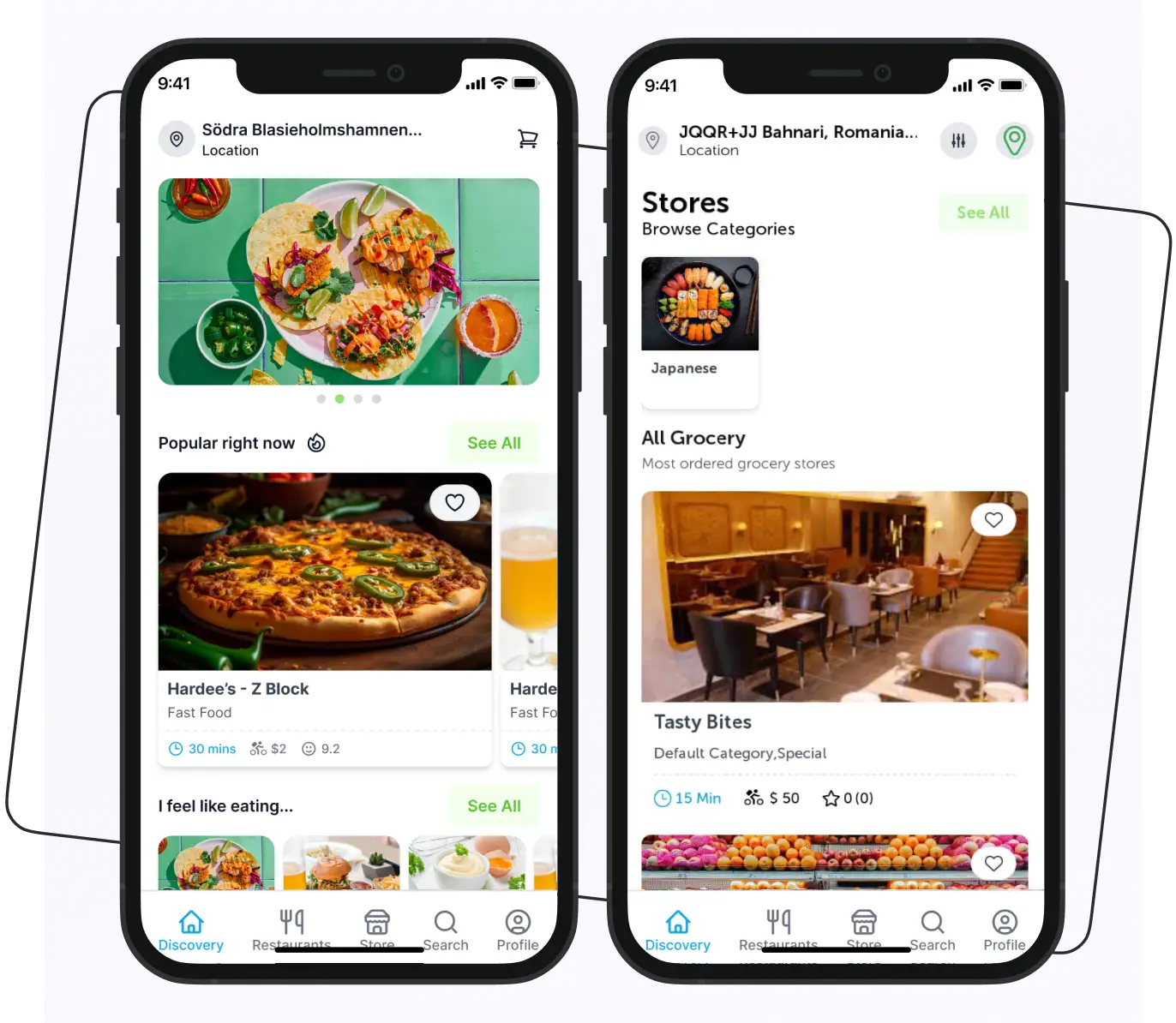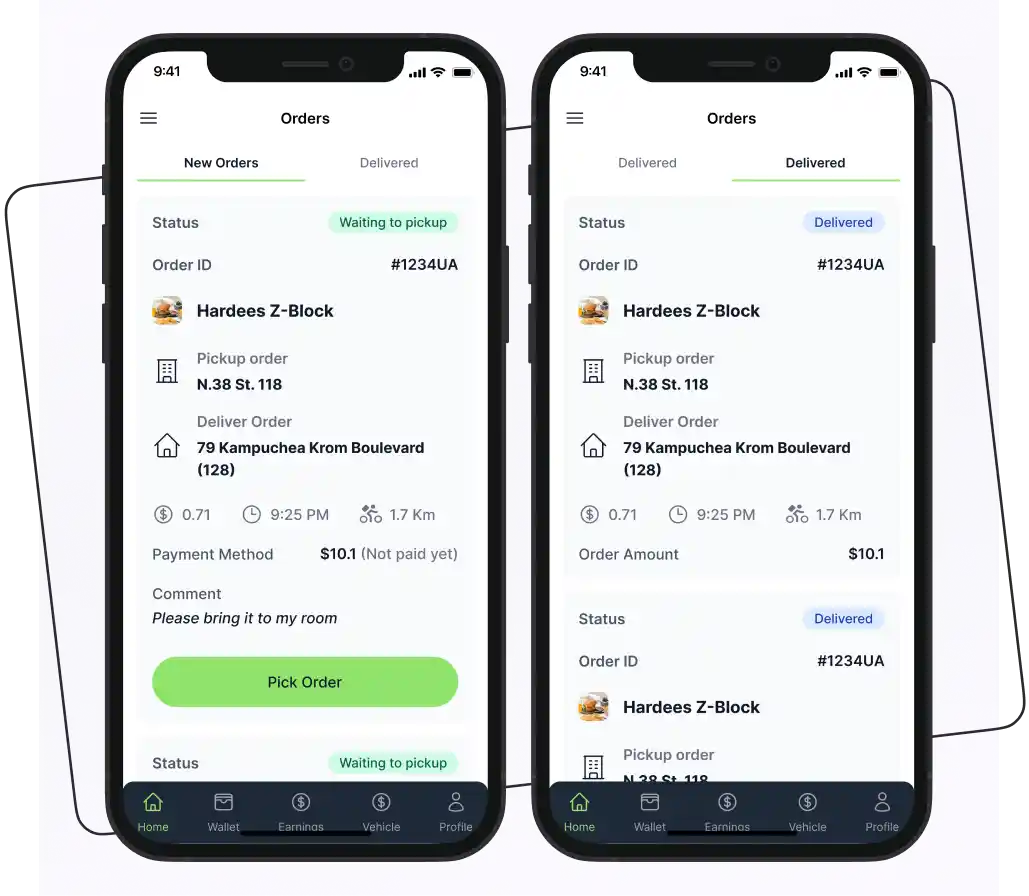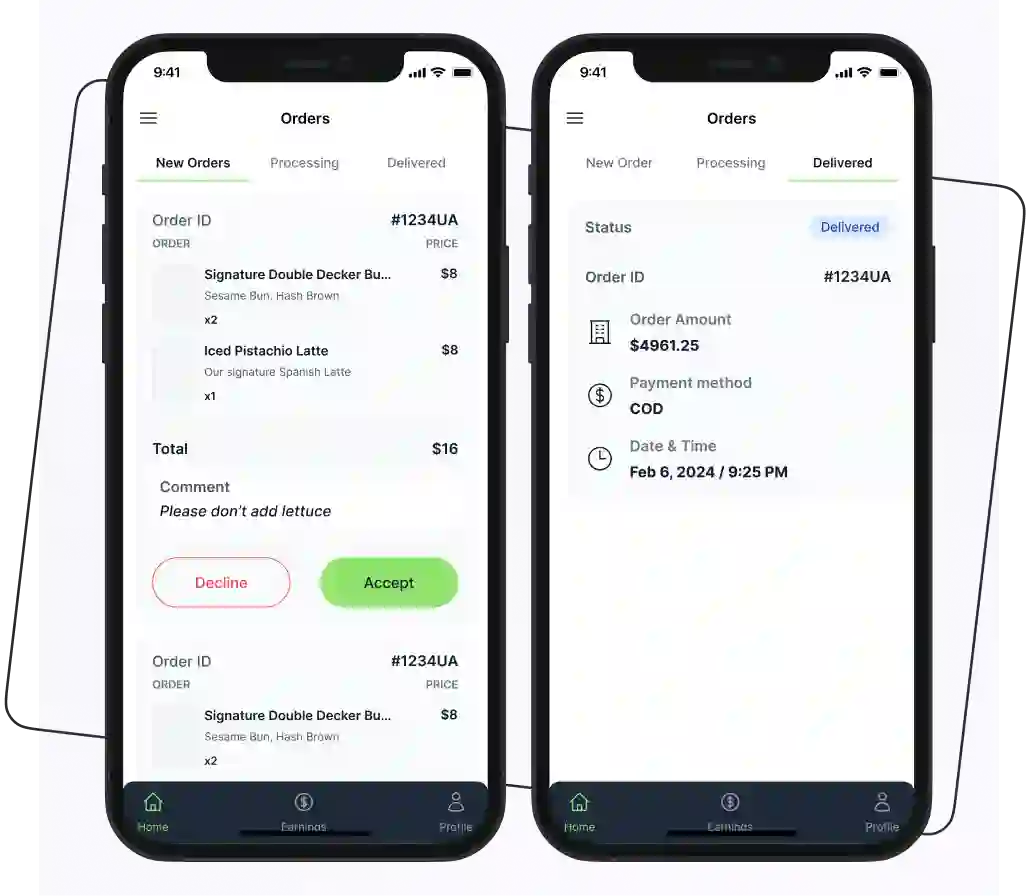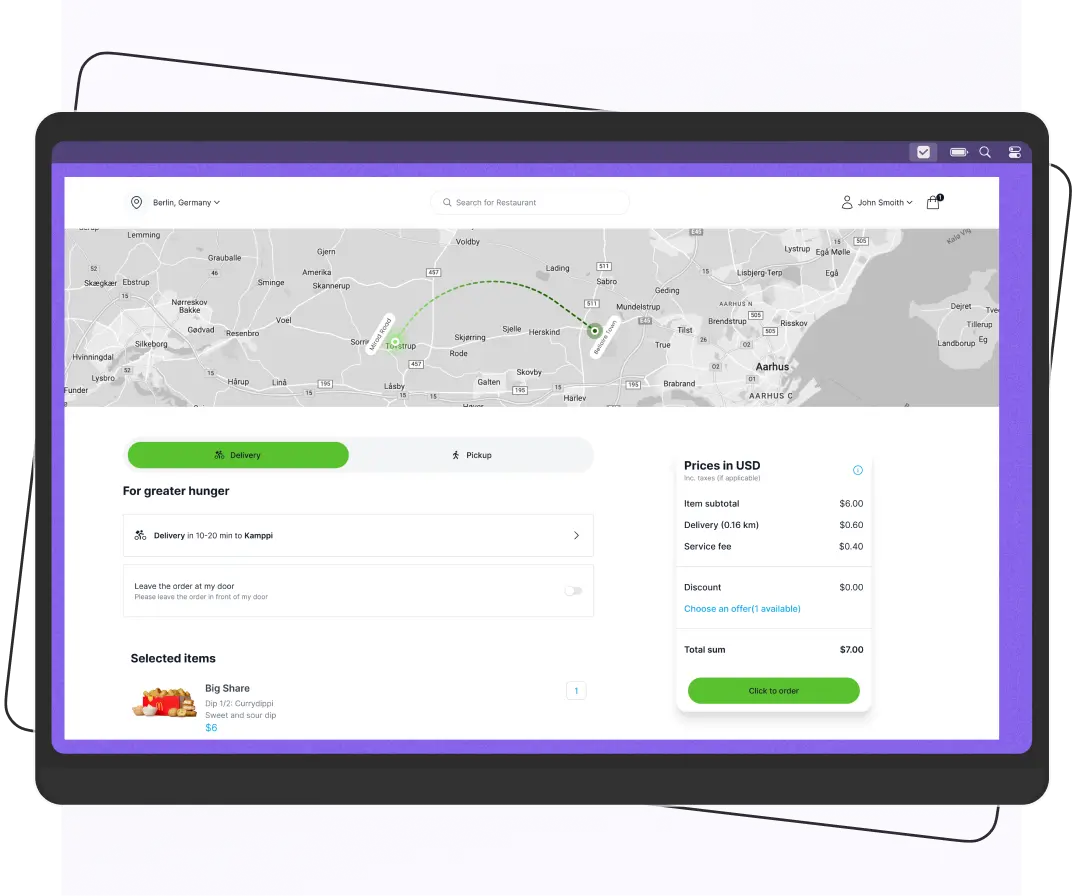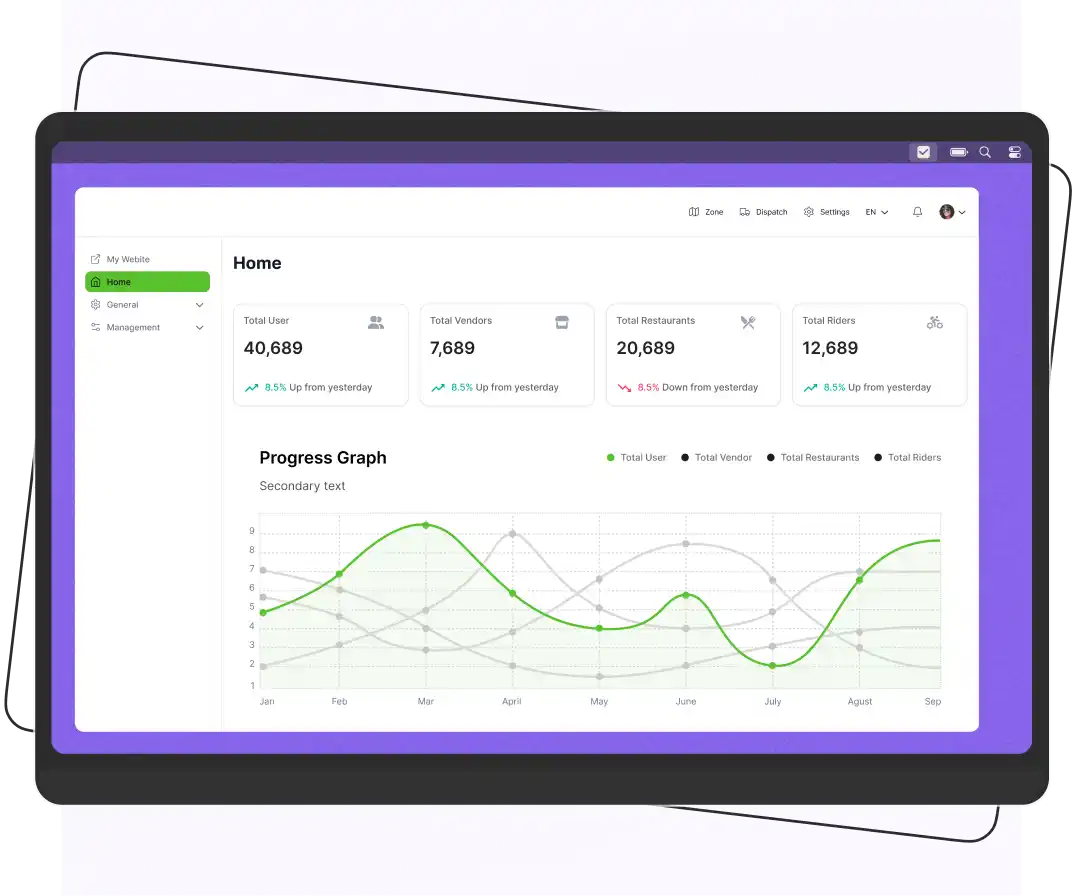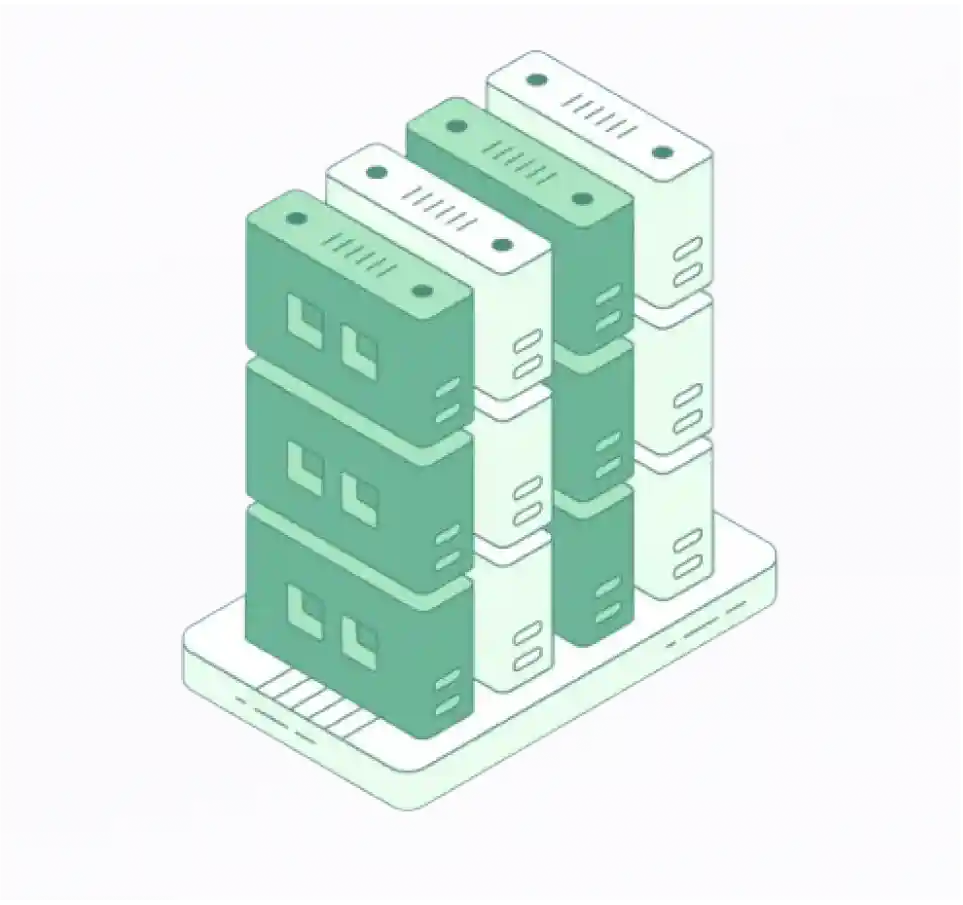
Key Takeaways
- DoorDash, Uber Eats, and Grubhub are top third-party platforms offering a wide reach but charge high commission fees.
- Enatega stands out with a 100% customizable solution, making it ideal for small businesses wanting more control over branding and operations.
- Postmates and Instacart cater to broader delivery categories like groceries and retail, offering flexibility beyond traditional food delivery.
- Third-party delivery platforms can help increase reach, improve operational efficiency, and boost visibility. However, often come with trade-offs like brand dilution and reduced profit margins.
- When choosing a delivery partner, consider cost, integration with POS systems, customer support, user interface, and brand recognition.
Tired of losing customers to big chains? In 2025, the right delivery partner can make all the difference. With the global food delivery market expected to grow to US$ 97,291.58 million by 2032 and 60% of people ordering takeout weekly, small businesses have a huge opportunity if they choose wisely.
Platforms like DoorDash, Uber Eats, and customizable options like Enatega offer transparent pricing, marketing tools, and room to grow. Not all services are created equal, so picking the right one is key to keeping your profits and your customers coming back.
Let’s explore the top picks for small food businesses this year!
Supercharge your deliveries with Enatega.
Launch NowWhich Food Delivery Service Is Best for Small Businesses?
Numerous food delivery services are available for small businesses, helping them compete in the food delivery sector. With these services, food business owners can bring in new sales from customers who prefer to order online.
Here is a list of the best food delivery apps that are helpful for small businesses.
1. DoorDash

DoorDash is the best food delivery service in the USA, partnering with all kinds of restaurants. The app allows you to manage all your customers and logistics without hassle. It also has one of the largest market reaches.
According to the Business of Apps, DoorDash partners with over 390,000 restaurants. With DoorDash, customers can order laundry detergent, makeup, and more and get it delivered to their doorstep.
Small business owners also create the DoorDash clone app for their food business and streamline their operations.
Pros of Using DoorDash
- Available throughout the USA
- Promote restaurants on its app and website
- Numerous POS integrations
Cons of Using DoorDash
- High commission fees
- Lack of control over delivery
- Brand dilution
Pricing
DoorDash charges restaurant owners commission fees ranging from 15% to 30% of the order total, along with potential setup and promotional costs. Specific pricing can vary based on location and individual agreements.
2. Enatega
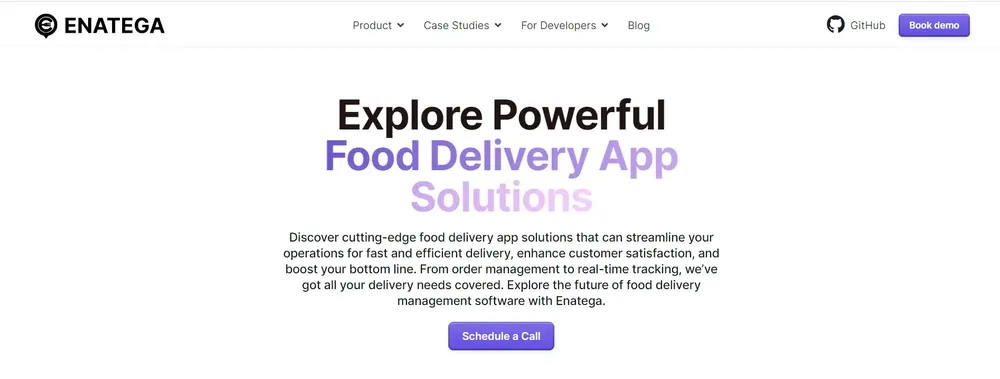
Enatega is a top-notch food delivery software that helps small businesses streamline their operations. With Enatega, food business owners can manage their orders online and provide better services to customers.
Pros of Using Enatega
- Upfront payment model
- Cater to all types and sizes of businesses
- Provide a restaurant app, a customer app, a rider app, and an admin dashboard
- 100% customizable and secure
- Demos are available
- Provide services to clients across the globe
Cons of Using Enatega
- Marketing is not included
Pricing
The pricing structure is flexible and affordable without hidden charges.
3. Grubhub

Grubhub is the best food delivery service for small businesses. It is particularly popular in larger cities such as Boston, Los Angeles, New York, Philadelphia, and Chicago. The company partners with over 365,000 restaurants in more than 4,000 cities in the United States.
The best thing about this food delivery service is that it offers a price calculator on its website that helps restaurants determine the projected monthly profit. It offers various marketing tools for merchants, as well as access to promotions, rewards, and loyalty programs.
Moreover, small business food delivery also creates a clone of Grubhub at affordable rates and manages their operations easily.
Pros of Using Grubhub
- Pay less if the customer orders via your website instead of the app
- Access to promotions and loyalty perks at higher plan levels
- The app layout is simple and clear
- Need access to a strong marketing suite
Cons of Using Grubhub
- Charge a 20% commission on all orders placed through the app
- No direct customer contact
- Lack of data and customer information
Pricing
Grubhub, the best food ordering app in the USA offers three pricing plans.
| Basic | Plus | Premium |
| Rates starting at 5% | Rates starting at 10% | Rates starting at 15% |
| Free, custom-branded ordering website | All of the features of the basic plan | All of the features of the Plus plan |
| Free professional menu photoshoot | Access to GH+ diners for eligible restaurants | Access to loyalty and promotion tools |
| On-demand access to account support | ||
| Zero platform or maintenance fees—list on Grubhub for free |
4. Postmates

Postmates is another great food delivery service for small businesses. They claim to be the nation’s largest on-demand delivery network. Partnering with them can help you manage your restaurant delivery and logistics problems.
Postmates was acquired by Uber on December 1, 2020. It still works as its service with its brand, but some behind-the-scenes operations, like using the same drivers, are now shared with Uber Eats.
Moreover, Postmates is available in more than 4,200 cities worldwide. It has worked with over 825,000 restaurants.
Pros of Using Postmates
- Easily gain exposure
- Larger delivery area
- Easily integrate with POS systems
- Wide selection of merchants
- Fast and reliable delivery
Cons of Using Postmates
- Service is a little pricey
- Lack of control
- Competition with larger chains
Pricing
This small business delivery service typically charges restaurant owners a commission fee on each order, depending on the agreement and service level. Additional fees may apply for promotions or delivery logistics.
5. Instacart
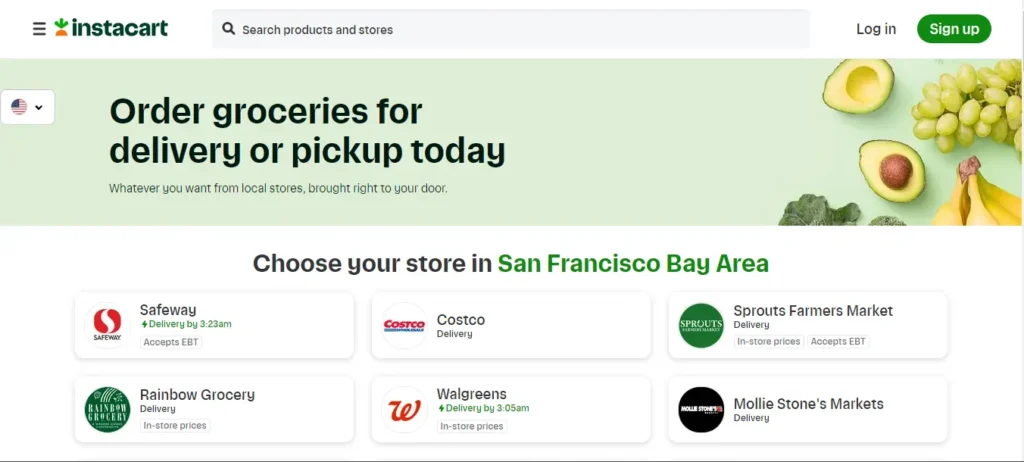
Instacart is the best solution for grocery stores. It is primarily focused on grocery delivery, while also offering alcohol and other retail delivery. This grocery delivery for small business can simplify their operations and enhance customer experience.
Furthermore, Instacart is a well-established name in the on-demand grocery delivery industry. It helps several grocery delivery businesses enter the market easily.
Pros of Using Instacart
- Take advantage of Instacart customer service
- Flexible delivery options
Cons of Using Instacart
- Not built-in POS integration
- Not disclose its fees online
Pricing
Instacart primarily focuses on grocery delivery, but if a restaurant partners with them, pricing usually involves a commission fee that can range from 15% to 25% per order, plus potential delivery fees. Specific terms may vary based on the partnership agreement.
6. Uber Eats

Uber Eats is the most well-known food delivery service in the US. The app delivers items other than food. Over the years, Uber Eats has won several accolades, including Best Food Delivery App in America.
Uber Eats has a more extensive global presence, operating in over 6,000 cities across 45 countries. With Uber Eats, small food businesses can expand their reach to a larger customer base without the need for their own delivery infrastructure.
Example
Sweetgreen: A popular chain of salad restaurants known for fresh, healthy meals.
Why Choose Uber Eats?
- Sweetgreen targets busy professionals and health-conscious customers, which makes Uber Eats a great fit. Uber Eats already has a large customer base in urban areas, giving Sweetgreen a chance to reach more customers without building its delivery system.
- Uber Eats allows Sweetgreen to set up a customized menu, showcasing their fresh, organic options while taking care of logistics (delivery, customer service) so Sweetgreen can focus on quality food.
- Uber Eats provides information on customer data (such as popular times and preferred orders), helping Sweetgreen optimize its offerings.
Pros of Using Uber Eats
- Simple and easy-to-use interface
- Small businesses can take advantage of name recognition
- Available globally
- No credit card processing fees for restaurants
Cons of Using Uber Eats
- Charge an activation fee
- 15% marketplace fee on every order when you have your delivery drivers
Pricing
UberEats offers four pricing plans.
| Lite | Plus | Premium | Self-delivery |
| 15% fee for delivery orders6% fee for pickup orders | 25% fee for delivery orders6% fee for pickup orders | 30% fee for delivery orders6% fee for pickup orders | 15% fee for self-delivery orders6% fee for pickup orders |
Comparison of Top Food Delivery Apps for Restaurants
The table below helps you make an informed decision according to your restaurant’s specific needs.
| Food Delivery App | Key Features | Benefits | Commission Fees | Availability |
| DoorDash | Large market reach, POS integrations, promo tools | Widely accessible, marketing opportunities | 15-30% | USA-based, over 390,000 restaurants |
| Grubhub | Promotions, loyalty programs, and price calculator | Simple interface, extensive marketing support | 20% | USA-based, over 365,000 restaurants |
| Uber Eats | Global reach, no credit card fees, easy interface | Trusted brand recognition, global market access | 15-30% | Global, over 6,000 cities |
| Postmates | Fast deliveries, wide merchant selection | Large delivery area, easily integrates with POS | 15-30% | USA-based, over 825,000 restaurants |
| Enatega | Customizable apps, and free demo options | Tailored solutions, global client base | Fixed pricing model | Global availability |
| Instacart | Focus on grocery and retail delivery, flexible | Great for grocery stores, reliable customer service | 15-25% | USA-based, popular with grocery stores |
Why is Third-Party Delivery Important for Food Businesses?
Using the third-party delivery service, food delivery businesses can get several benefits, which include:

Expanded Customer Reach
Third-party delivery platforms have a wide customer base. They have an online infrastructure that allows food businesses to reach a larger audience. This expanded reach can help attract new customers and increase sales.
Convenience and Customer Preferences
Many consumers today prefer the convenience of ordering food online and having it delivered to their doorstep. Third-party delivery services provide a seamless ordering and delivery experience, allowing customers to easily access a variety of food options from different restaurants in one place.
By partnering with these platforms, food businesses can cater to customer preferences and easily grow in the online food delivery market.
Increased Visibility and Marketing Opportunities
Joining a third-party delivery platform can provide food businesses with increased visibility and exposure. Additionally, the platforms invest in marketing and advertising to drive traffic that benefits the partnered food businesses.
Operational Efficiency
Managing delivery logistics is a complex task that requires dedicated resources, including delivery personnel, vehicles, and technology infrastructure. Using third-party delivery services can benefit food businesses and lead to improved operational efficiency and cost savings.
Adaptation to Changing Market Dynamics
The food industry has witnessed a significant shift towards online ordering and delivery, especially in recent years. By using third-party delivery, food businesses can adapt to these changing market dynamics and remain competitive. It allows them to keep up with consumer expectations and participate in the digital transformation of the industry.
Drawbacks of Third-Party Delivery Platforms
Third-party delivery platforms have some drawbacks, such as:
Limited Control Over Customer Experience: Businesses often have limited control over the entire customer journey, from order placement to delivery, which can impact customer satisfaction.
Brand Differentiation Challenges: Standing out among numerous competing brands on these platforms can be difficult, making it harder to establish a unique identity.
High Commission Fees: The fees charged by these platforms can significantly reduce profit margins, affecting overall profitability.
Order Management Complexity: Juggling orders from multiple platforms can complicate operations, leading to potential errors and inefficiencies.
How to Choose a Food Delivery Platform for Your Restaurant?
When selecting the delivery services for small food businesses, you need to consider various factors that will impact your business. Below are some tips to keep in mind that help you in selecting the food delivery service for small businesses.
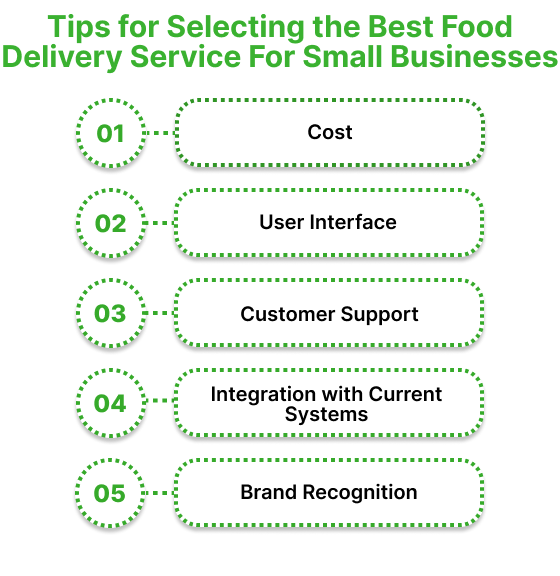
Cost
Cost is an important factor in selecting the best food delivery service. You must understand the fees or commissions charged by the app. The price will help you make the correct decision.
User Interface
Make sure the design is easy for your team and the customers to use the app. If the design is complex, you will face several problems in managing your business, and the app’s performance impacts the user experience.
Customer Support
Always look for the food-delivering services that provide the best customer support. If you face any problem, they will quickly respond and solve your issues as soon as possible.
Integration with Current Systems
Choose those restaurant food delivery services that can easily integrate with your existing system.
Brand Recognition
One of the major factors to consider when choosing a service is brand recognition. Make sure the app is popular and customers trust the app.
FAQs
1. Are third-party delivery services worth it?
Third-party delivery services can be worth it for businesses looking to expand their reach and improve convenience. However, their value depends on specific needs, costs, and customer preferences.
2. Who are the top food delivery services?
The top food delivery services are:
- DoorDash
- Caviar
- Chow Now
- Seamless
- Zomato
3. Why food delivery services?
Below are some reasons that show why food delivery services are the best.
- People can get their food at home.
- A wide variety of options are available.
- Restaurants can improve their visibility.
- Restaurants can reach a larger number of customers.
4. What is food delivery management?
Food delivery management software allows you to manage orders, delivery routes, manage inventory, track orders, and more.
5. Which delivery app is best for small businesses?
Instacart, DoorDash, Uber Eats, Postmates, and Grubhub are the best delivery apps for small businesses.
6. How do I make a free food delivery app?
Below are some steps to help you create a free food delivery app.
- Identify your business idea
- Select the business model
- Select the app features
- Start the development
- Testing and launch
7. What is the most profitable food delivery service?
DoorDash is often considered the most profitable food delivery service, leading the market in terms of revenue and market share. Other notable competitors include Uber Eats and Grubhub, but DoorDash consistently outperforms them in profitability.
8. Which is the most used food delivery service?
DoorDash is the most used food delivery service in the United States, holding the largest market share, followed by Uber Eats and Grubhub.
9. Which food delivery service is best for restaurant owners?
The best food delivery service for restaurant owners is DoorDash and Uber Eats. They are popular for their extensive reach and marketing support.
10. Who provides top-notch grocery and alcohol delivery services in the food delivery business?
Top-notch grocery and alcohol delivery services are provided by companies like Instacart and Drizly, known for their quick delivery and wide selection.
11. Which food delivery service is best for home-based businesses?
For home-based businesses, DoorDash and Uber Eats are often considered the best due to their extensive reach, user-friendly platforms, and promotional support for small vendors.
12. How do third-party delivery fees impact restaurant profitability?
Third-party delivery fees can impact restaurant profitability by reducing margins. These fees range from 15% to 30% of the order total, which cuts into profits. Additionally, reliance on third-party services may lead to increased menu prices or reduced quality, affecting customer satisfaction.
13. Who has the lowest fees for food delivery?
For smaller orders, DoorDash has the lowest fees. However, for larger orders, Grubhub or Uber Eats might be cheaper than DoorDash.
Supercharge your deliveries with Enatega.
Launch NowConclusion
Using the best food delivery services can help your business boost sales and enhance customer satisfaction. You can gain more customers by providing the best services for placing orders online.
To choose the best food delivery services, you can analyze the third-party delivery apps based on pricing, commission fees, delivery options, and more.
Furthermore, if you’re running a food business and want to create an app that helps you simplify your operations, you can book a demo with us. We have experts who create the best food delivery apps like iFood clone , Talabat clone, and more.
So, create a food app and grow your business online.












 IOS
IOS Android
Android Web
Web